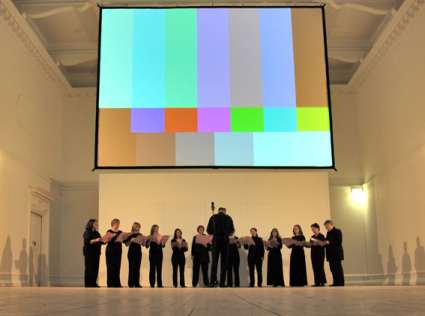Test Signal
Test Signal was commissioned by Phil Coy as a software project to interpret sound to generate bars of colour. The brief was to create a dynamic display inspired by television test signal pictures that would change its colours in reaction to changing sounds. Phil has recently put his own site together, complete with photos of Test Signal in action in conjunction with the New London Chamber Choir at the South London Gallery, 23rd March 2006.

Image courtesy of Phil Coy ©
The physics of sound
Sound is produced by minuscule vibrations in the air surrounding us. The frequency of these vibrations determines the pitch of the sound - the higher the frequency, the higher the note. However, sound made up from just one frequency is rare; the tone emitted by a television test signal is an example of such a “pure” signal. Almost all sound, and certainly anything commonly considered music, is made up from a large number of tones vibrating at different frequencies at the same time. Even a single musical instrument playing a particular note, e.g. the concert ‘A’ (defined as sound of frequency 440Hz), will emit a sound containing weaker vibrations at many other frequencies. In fact, it is the particular make up of these other frequencies that define the timbre of an instrument and cause the ‘A’ played on a piano to sound different from an ‘A’ played on a violin or sung by a human voice.
Sound analysis
By analysing a sound signal it is possible to establish its constituent frequencies and the strength of the vibration (amplitude) at each frequency. This combination of frequency and amplitude is called the frequency spectrum. The analysis to produce this spectrum is called Fourier Transformation. Of course, sound from music changes all the time which means that the spectrum is constantly changing. In the Test Signal application, a process known as Fast Fourier Transformation is repeatedly applied to a sound signal to produce its spectrum as it changes. Each of these spectrums contains information about the current amplitudes of the music of frequencies between 0 and 20,000Hz.
Visualising a spectrum
The Test Signal program must be calibrated at first. This involves the Test Signal program computing the spectrum of a small portion of the music to be analysed. The average spectrum for the calibration period is taken, then split into 20 sections. The average amplitude of each section is then assigned to the appropriate starting colour from the test signal picture. This calibration information is used so that whenever the same sound as was heard during the calibration period is heard again, then the same starting colour is shown on the display.
As the music changes, the average amplitude of each section of the current spectrum will change accordingly. If the amplitude decreases, then a lighter colour is chosen. Likewise, if the amplitude increases, then a darker colour is shown.
